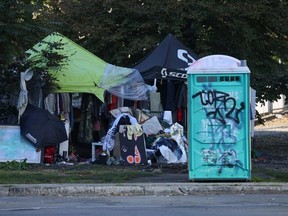‘Black-mandated’ homeless shelter on way, City Hall confirms

Article content
Toronto officials are taking applications until Friday for city council’s new “Black-mandated” shelter, where everyone from employees to the homeless could be excluded on the basis of race.
City Hall has also decreed that experience in running a shelter is not a requirement for those submitting applications.
The city’s shelter and support services division says the new shelter will help make Toronto’s services “reflective of the diversity of the city,” but offered no specifics as to where it would go or when it might open.
A city document says shelter services is developing “at least one Black-mandated shelter” by 2033. That document – a set of guidelines for prospective applicants for the shelter contract – says the intention is “to provide opportunities” for Black-mandated non-profits, “also referred to as B3,” the document says.
It defines a B3 as “an organization that is led by a majority of paid staff and board members who self-identify as Black or are of African descent.” A B3 must serve “Toronto’s diverse Black communities,” both in practice and in an explicit mandate.
While an applicant must meet those requirements to be eligible, one thing that isn’t required is experience in running a shelter.
Shelter services “welcomes applications” from B3s “with less than one year of experience operating a shelter,” the document says, but such groups are “encouraged” to find a mentor.
The expectations are unclear, as the document at another point references B3s that haven’t operated a shelter for a year “but do have experience in providing other services to Black individuals experiencing homelessness.” Meanwhile, a slide deck from an April presentation says applicants without a year of experience “will be required” to find mentors, including for shelter operations and asset management.
The guidelines document is 22 pages long, and includes a four-page glossary of terms such as “anti-racism,” “diaspora,” “interpersonal racism” and “structural racism.” The section on providing financial details, meanwhile, consists of two short paragraphs.
Recommended video
The document lists a number of operational requirements for the shelter, such as running 24/7 all year long and committing to audits by City Hall. Some of the requirements appear specific to this shelter, such as stipulated “safe spaces for Black clients and staff,” “culturally appropriate food and nutrition” and Black-specific toiletries and hygiene products as laid out in the city’s confronting anti-Black racism, or CABR, directives.
It’s unclear just how the residents would be matched with the shelter, or if someone could be turned away because of race.
The document says the shelter should house roughly 70 to 100 people, and “accommodate all clients within the applicable sector, regardless of their unique identity and support needs.” Some of the examples include age, gender, race and substance use. But the city’s shelter standards define “sector” as a subcategory to designate a shelter as strictly for one group – for example, men or women. It’s unclear if the B3 shelter would represent a new Black-only sector.

The B3 shelter competition follows a similar process for an Indigenous shelter, which could move to construction as soon as this year.
That competition’s guidelines didn’t list definitions for “racism” or call for “safe spaces,” and while that document also makes no mention of racial mandates, a related slide deck says the operator’s upper management must be at least half Indigenous – but with no race requirement for regular staff, as with the B3 document.
City Hall declined to make anyone available to TheToronto Sun for an interview about the new shelter. In a statement, Loretta Ramadhin, shelter services’ planning director, told the Sun it is “important to ensure community services are reflective of the diversity in our city.
“Black individuals are over-represented among people experiencing homelessness,” Ramadhin said, citing a 2021 study that found they make up 9% of Toronto as a whole, but 31% of its homeless population. The need has only grown amid an “unprecedented” surge of refugee claimants in the city in the years since, she said.
“Solutions to these complex challenges cannot be one size fits all. We remain committed to being nimble to tailor homelessness services to best suit the range of needs we see in Toronto,” Ramadhin said.
While city representatives would not give details about the number of applications received, or where it’s likely a B3 shelter might go, the city said in an email that the winning applicant will be picked this year, with an opening date expected between 2028 and 2030.
Plans for the B3 shelter were mentioned in shelter services’ recently released 2024 annual report, which hints at the division’s focus on race. That 40-page document contains a page with pie charts about shelter services’ $800-million budget, but also includes a full page for a land acknowledgment, another full page for the city’s African ancestral acknowledgment and a four-page “equity and inclusion” section.
A recent survey of people in and around the shelter system found that of the 6% of respondents who think Toronto’s homelessness services have improved in the last five years, many appreciated the city’s “use of an equity lens and addressing diverse needs.” However, the vast majority of respondents, 66%, said services are worse now than five years ago.














Postmedia is committed to maintaining a lively but civil forum for discussion. Please keep comments relevant and respectful. Comments may take up to an hour to appear on the site. You will receive an email if there is a reply to your comment, an update to a thread you follow or if a user you follow comments. Visit our Community Guidelines for more information.